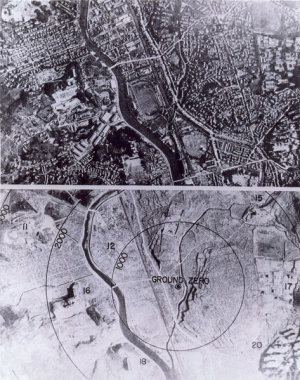![]() The Pacific War Online Encyclopedia
The Pacific War Online Encyclopedia
|
| Previous: Nagara Class, Japanese Light Cruisers | Table of Contents | Next: Nagasawa Saburo |
Nagasaki (129.862E 32.758N) is a major port and industrial city on the island of Kyushu, with large coal deposits in the nearby hills. The population in 1940 was about 253,000 persons. The coal mines of Kyushu produced 40% of Japan's domestic coal, something in the ballpark of 7.3 million tons in 1941. The Mitsubishi shipyard was the largest in Japan, employing 36,391 workers and capable of building all types of ships. The battleship Musashi was laid down here, and a number of cruisers were built. The Mitsubishi Ordnance Works were also located here, along with a couple of small aircraft factories. The port was protected by a heavy artillery fortress regiment
Nagasaki was a small village when it
became the first Japanese
port opened to foreign ships in the 16th
century. Christian
missionaries were active here and Nagasaki continued to have the
largest Christian
community in Japan up to the time of the war.

National Archives. Via Wikimedia Commons
Nagasaki was destroyed on August, 8, 1945,
by "Fat Man," the second and last
nuclear bomb
dropped on Japan during the war. This mission went poorly.
The fuel pump for the reserve fuel tank of the attacking B-29 Superfortress, Bock's Car,
was malfunctioning, but
the mission was ordered to proceed anyway, lest it be delayed several
days by an approaching storm front. One of the accompanying observation
B-29s failed to make the rendezvous over the island of Yakoshima (130.496E 30.335N), causing Bock's Car to expend more precious fuel circling and waiting for the missing aircraft. Weather conditions were already
deteriorating as Bock's Car
approached Japan, and three passes over the primary target, Kokura, failed because of heavy
ground
haze obscuring the target. Bock's Car
then turned towards Nagasaki with just enough fuel for a single pass
before proceeding to Okinawa.
Nagasaki was also obscured by poor weather, but the mission commander,
Charles Sweeney, chose to disregard orders not to bomb by radar rather than attempt a landing
with "Fat Man" still on board or jettison "Fat Man" into the ocean.
The bombardier reported that the clouds cleared over the
target just as he was making his run ("The target was there, pretty as a
picture") and the bomb exploded over a point 500' (150 m) south of the
Mitsubishi Steel and Arms Works in the Urakami district, some distance
from the docks and city center. The explosion also destroyed a
Mitsubishi torpedo factory and
the Urakami Catholic Cathedral. About half of the 14,000 Japanese
Catholics in Nagasaki were killed in the blast. Because of the hilly terrain and the aiming point some distance from the city center,
damage was less than at Hiroshima
in spite of the greater explosive yield of "Fat Man" (about 22
kilotons.) Immediate deaths numbered about 40,000 persons.
The fact that ground zero was fully a mile and a half
northwest of the city center has stirred controversy. At least one
historian has suggested that the bombing was conducted entirely by radar
and the mission report falsified to cover up this fact. Other
historians accept the report that a window opened in the clouds at the
last minute, but do not attempt to explain why the drop was so far from
the city center. The implication is that the bombardier picked as his
aiming point the first prominent feature visible in the city, allowing
the attack to technically comply with the strict orders for visual
bombing, avoiding entirely wasting the weapon by jettisoning it into the
sea, and giving Bock's Car a fighting chance to make it to Okinawa on its remaining fuel.
Following the attack, Bock's Car was so low on
fuel that Sweeney began "flying the steps", carefully trading altitude
for speed to stretch the fuel supply. One engine stopped from fuel
starvation as the aircraft made its landing approach, a second stopped
on the runway, and a third stopped just as the aircraft came to a halt.
The aircraft had seven gallons of gasoline left, not counting the 600 gallons trapped in the tank with the defective pump.
The Americans
felt
that the early use of a second nuclear weapon was necessary to convince
the Japanese that more were available in their arsenal. In fact,
Manhattan Project leaders estimated that seven more bombs would be
ready by 31 October 1945. Tokyo was
originally to be the next target, but intelligence reports of a
massive Japanese buildup on Kyushu
led Marshall to ask that
the remaining bombs be reserved for tactical use in case an invasion of Japan was
ordered.
Kyushu Hikoki K.K. The production schedule of this small aircraft factory was approximately as follows:
| Aircraft Type | Average Airframes Per Month | Starting Month | Ending Month |
|---|---|---|---|
| E13A Jake |
26 | <1941-12 | 1945-8 |
| Q1W Lorna | 6 | 1943-9 | 1945-8 |
| Yard |
Floor Space |
Building Way Length |
Merchant Tonnage |
Naval Tonnage |
|---|---|---|---|---|
| Mitsubishi |
4179 |
4039 |
8027 |
3389 |
| Koyagijima-Kawaminami |
409 |
2952 |
8340 |
0 |
| Fukahori-Kawaminami |
928 |
1181 |
3067 |
0 |
Climate Information:
Elevation: 436'
Temperatures: Jan 49/36, Apr 66/50, Jul 85/73, Oct 72/58, record 98/22
Rainfall: Jan 11/2.8, Apr 11/7.3, Jul 10/10.1, Oct 6/4.5 == 75.5" per annum
References
Francillon
(1979)
Frank (1999)
The Pacific War Online Encyclopedia © 2007-2009, 2011, 2013-2014 by Kent G. Budge. Index